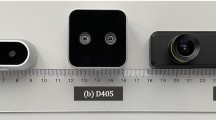Abstract
Background
Laparoscopic surgery requires surgeons to rely on visual clues for discrimination among differing tissues and for depth of field on a two-dimensional screen. High definition (HD) provides a superior image. If there is a measurable advantage with HD television (TV), the increase in the cost of the technology would be justified.
Methods
A digital three-chip CCD camera with a standard monitor (SD system) and a true HD camera (1,080 pixels) with a 16:9-ratio HD monitor (HD system) were compared in clinical and laboratory settings. Three experiments were performed: (1) subjective visual evaluation of the HD and SD systems during actual surgical cases, (2) subjective visual evaluation in a controlled laboratory surgical setting with simultaneous parallel recording, and (3) three laparoscopic surgical task evaluations in a laboratory setting, namely, task A (metric analysis of participants on the surgical simulator), task B (simple eye–hand coordination performance), and task C (knot tying).
Results
All 53 participants subjectively evaluated HD as superior to SD in the laboratory setting and during actual surgery. In task B, there was no significant difference between SD and HD (dominant hand: p = 0.19; nondominant hand: p = 0.07). In task C, the knot-tying time was significantly less when performed with HD (mean, 173 ± 84 s vs 214 ± 107 s; p = 0.003). Most importantly, subjects with less skill (more documented time required in the basic module on a surgical simulator) improved significantly in the knot-tying task with the HD system (R = 0.631; p = 0.005).
Conclusion
All the participants preferred HD to SD. High definition significantly improved laparoscopic knot tying, which requires precise depth perception, proving that HD is more than just a pretty picture.







Similar content being viewed by others
References
Bhayani SB, Andriole GL (2005) Three-Dimensional (3D) Vision: Does It Improve Laparoscopic Skills? An Assessment of a 3D Head-Mounted Visualization System. Rev Urol 7(4):211–214
Szold A (2005) Seeing is believing: visualization systems in endoscopic surgery (video, HDTV,stereoscopy, and beyond). Surg Endosc 19:730–733
Falk V, Mintz D, Grunenfelder J, Fann JI, Burdon TA (2001) Influence of three-dimensional vision on surgical telemanipulator performance. Surg Endosc 15:1282–1288
Otto KJ, Hapner ER, Baker M, Johns MM III (2006) Blinded evaluation of the effects of high definition and magnification on perceived image quality in laryngeal imaging. Ann Otol Rhinol Laryngol 115:110–113
van Bergen P, Kunert W, Buess GF (2000) The effect of high-definition imaging on surgical task efficiency in minimally invasive surgery: an experimental comparison between three-dimensional imaging and direct vision through a stereoscopic TEM rectoscope. Surg Endosc 14:71–74
Berci G, Wren SM, Stain SC, Peters J, Paz-Partlow M (1995) Individual assessment of visual perception by surgeons observing the same laparoscopic organs with various imaging systems. Surg Endosc 9:967–973
Hiatt JR, Shabot MM, Phillips EH, Haines RF, Grant TL (1996) Telesurgery: acceptability of compressed video for remote surgical proctoring. Arch Surg 131:396–401
Yamaguchi S, Konishi K, Yasunaga T, Yoshida D, Kinjo N, Kobayashi K, Ieiri S, Okazaki K, Nakashima H, Tanoue K, Maehara Y, Hashizume M (2007) Construct validity for eye–hand coordination skill on a virtual reality laparoscopic surgical simulator. Surg Endosc DOI: 10.1007/s00464-007-9362-1, May 4, 2007 (Epub)
Song CG, Park SK (2005) Performance evaluation of stereo endoscopic imaging system incorporating TFT-LCD. J Med Eng Technol 29:244–250
Acknowledgments
Dr. Edward H. Phillips received an unrestricted educational research grant from Karl Storz Endoscopy company, and Dr. George Berci received an unrestricted research grant from Karl Storz Endoscopy company.
Author information
Authors and Affiliations
Corresponding author
Rights and permissions
About this article
Cite this article
Hagiike, M., Phillips, E.H. & Berci, G. Performance differences in laparoscopic surgical skills between true high-definition and three-chip CCD video systems. Surg Endosc 21, 1849–1854 (2007). https://doi.org/10.1007/s00464-007-9541-0
Received:
Accepted:
Published:
Issue Date:
DOI: https://doi.org/10.1007/s00464-007-9541-0




